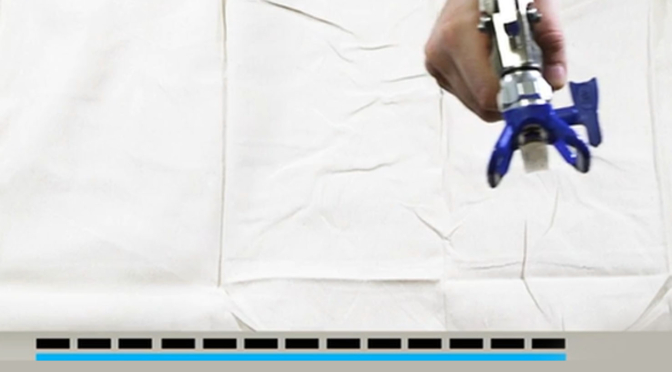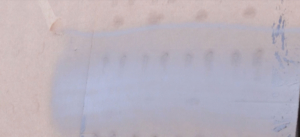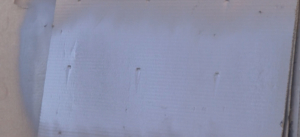4 factors that could boost your airless sprayer’s quality and productivity
Airless paint sprayers are known for delivering a consistent and high-quality finish—assuming everything is working properly. But your sprayer’s spray pattern is really the result of four different factors combining together to deliver a beautiful, even finish: pressure, tip selection, filtration, and technique.
That means if your finish is looking subpar, the problem might be in one of these four areas. Nolan Buss, Product Marketing Manager for Graco’s contractor equipment division, offers these tips for troubleshooting your sprayer and getting the best spray pattern possible.
Pressure
It’s important to find the sweet spot when it comes to pressure. If your sprayer is using too little pressure, you’ll encounter “tailing” in your fan pattern.
“Tailing is when you end up with a small fan pattern in the middle and two heavy edges, or ‘tails,’ on the outside of the fan pattern,” Buss says. “It means that when you overlap that fan pattern by 50 percent—which is what’s recommended in the market today—you’re going to have a higher mil build in the center of that pattern than you are on the outside of the fan pattern. So it’s more difficult to overlap seamlessly.”
(Above: a spray pattern with a noticeable “tail” along the top; below: a spray pattern with proper pressure and no tailing)
To fix a tailing fan pattern, increase your sprayer’s pressure until there are no tails whatsoever on the outside of the fan pattern.
Of course, increasing the pressure too much can lead to another problem: overspray. When paint exits a sprayer tip, it’s completely atomized into very small particles to provide the best finish. When it leaves the tip with too much pressure, though, it hits the surface and bounces off, because it’s moving too fast.
“That overspray—that cloud of paint—is paint that leaves your bucket and lands on the floor,” Buss says. “That’s money wasted.”
Each tip has a number, such as 515 or 317. The first part of that number indicates half the width in inches of the fan pattern. The second part of that number (the last two digits) indicates the diameter of the orifice of the tip in thousandths of an inch. So for example, a 515 tip will have a 10-inch wide fan pattern, and has a diameter of 15 thousandths of an inch.
Pay attention to these numbers, because choosing the right tip for the job will affect the quality of your finish and overall sprayer performance. Generally, light coatings like stains will require a small tip, while heavier coatings like texture or heavy latex need a larger tip. Other factors can also affect tip selection, such as special “low pressure” models that lengthen the life of the tip and reduce overspray.
When it comes to replacing tips, Buss says the best practice is to replace a tip when your fan pattern has reduced its pattern width by 20% of the original fan pattern. For example, if the width of a 515’s spray pattern is down to eight inches or less, it’s time to replace that 515. Failing to replace it will result in inconsistent milling and overspray.
Filtration
Filtration is another important factor when it comes to getting a great spray pattern and preventing against tip clogs.
“If paint is sitting open, contaminants can get in. Dirt and debris can also be on your sprayer. And when you put the sprayer into paint, they can travel through the manifold lines and travel up to your gun,” Buss says.
He continues: “The right filtration will block those contaminants from traveling through the sprayer and will keep the paint through the paint hose perfectly clean, so that you don’t get tip clogs in your spray pattern.”
Buss recommends the RAC X Low Pressure SwitchTips for painters working on residential and commercial exteriors, and RAC X Fine Finish Low Pressure SwitchTips for painters who specialize in cabinets, doors, trim, crown-molding and other fine-finish projects. Both of these tips feature low-pressure technology, helping contractors reduce expensive paint waste via overspray by 50%, while also doubling the life of the tip. These RAC (Reverse-a-Clean) tips also allow painters to reverse the tip when clogs occurs, spray the debris into a wastebin, and return to work—without any consequence or delay to your spraying work.
Technique
Of course, the best spray technology in the world won’t help if the painter’s technique is lousy. Technique plays an important role in sprayer performance.
Buss suggests painters should be 12-18 inches from the surface they’re spraying as they make a pass. The spray gun should be perfectly perpendicular to the surface while making each pass with the spray gun; failing to do so will result in an uneven finish and excess overspray.
(Above: an overly light spray pattern; below: an overly heavy spray pattern)
The speed of application will also affect the end result. Moving too quickly will result in material coverage that is too light, while slow movement will result in heavy material coverage that drips (see above).
Tip spits can also occur when the gun’s trigger is released while still over the sprayed surface. Graco’s Ultimate QuickShot and the new Contractor PowerShot feature electronic airless guns, virtually eliminating tip spits for the perfect airless finish. You can find more spraying technique advice, including specific movement patterns for optimal finish, here.
Conclusion
Using these four factors to get the best performance out of your airless sprayer isn’t just about getting your money’s worth out of your equipment. It’s about setting up your business for long-term success, both in customer reputation and financial gains.
“If you lay down the perfect airless finish and perfect fan pattern on the first try, your client isn’t going to have to call you back and ask you to do touch-ups,” Buss says. “Investing the effort to get a great spray pattern means you’ll not only do better quality work, but you’ll have fewer callbacks, meaning you can take on more jobs in a single year and generate higher profits for your company.”






